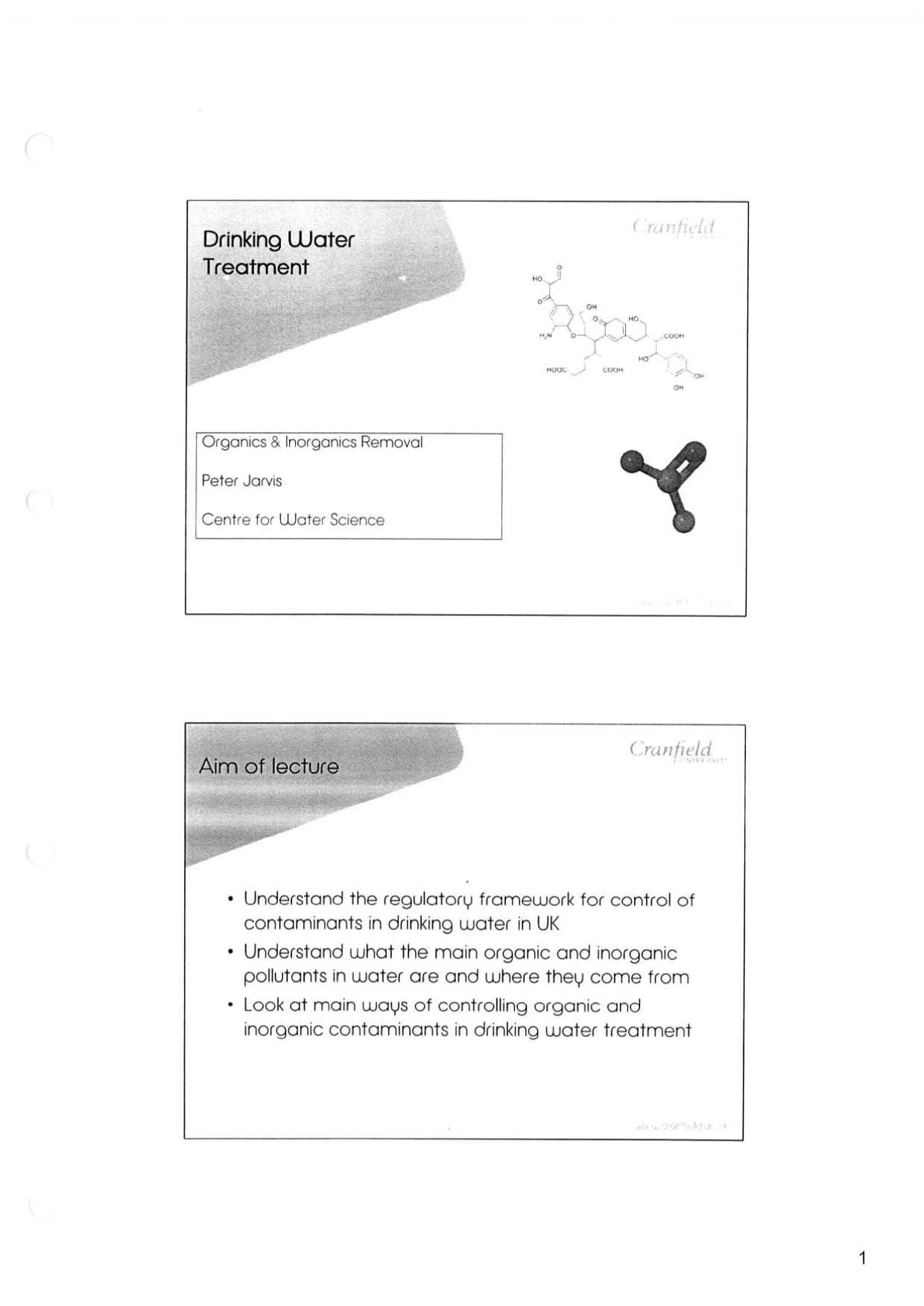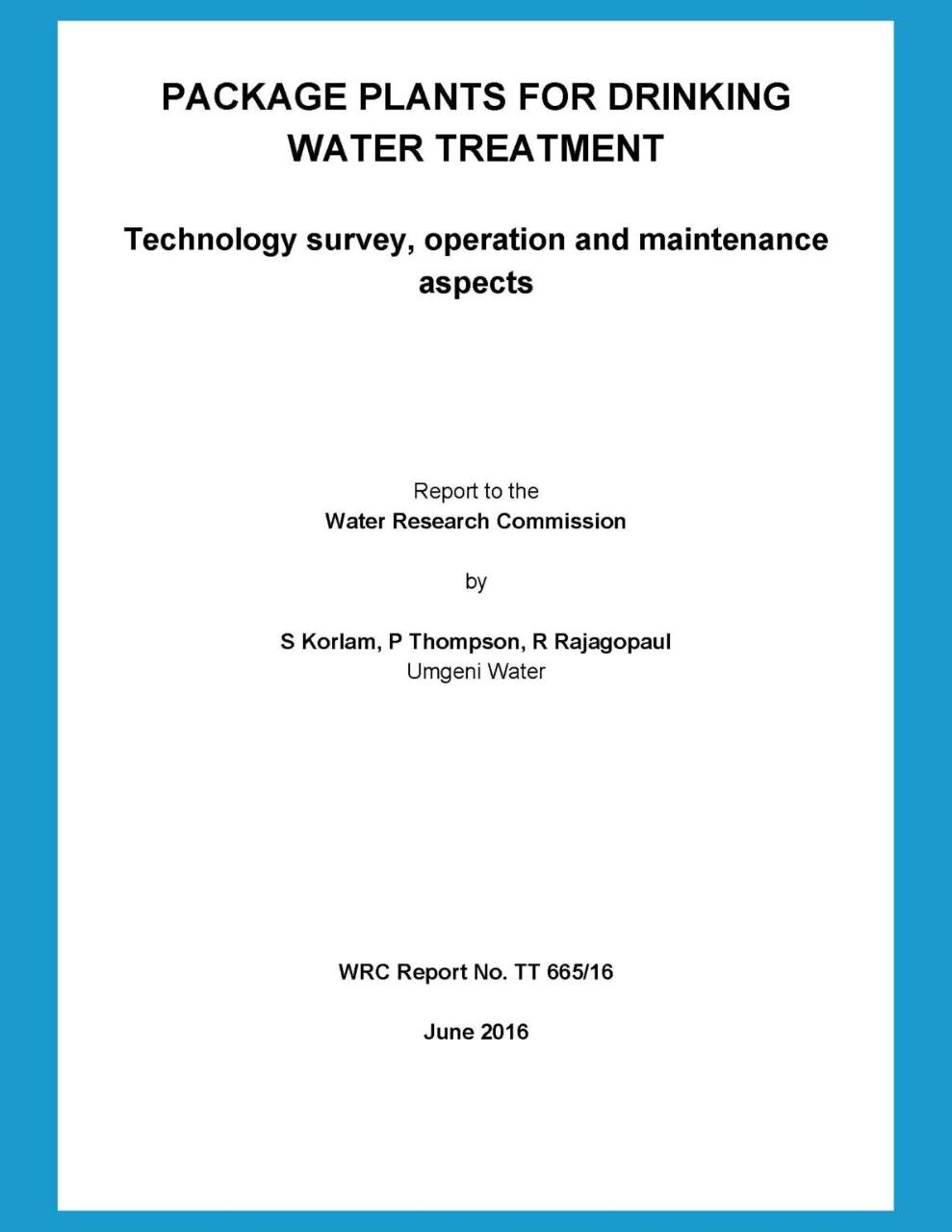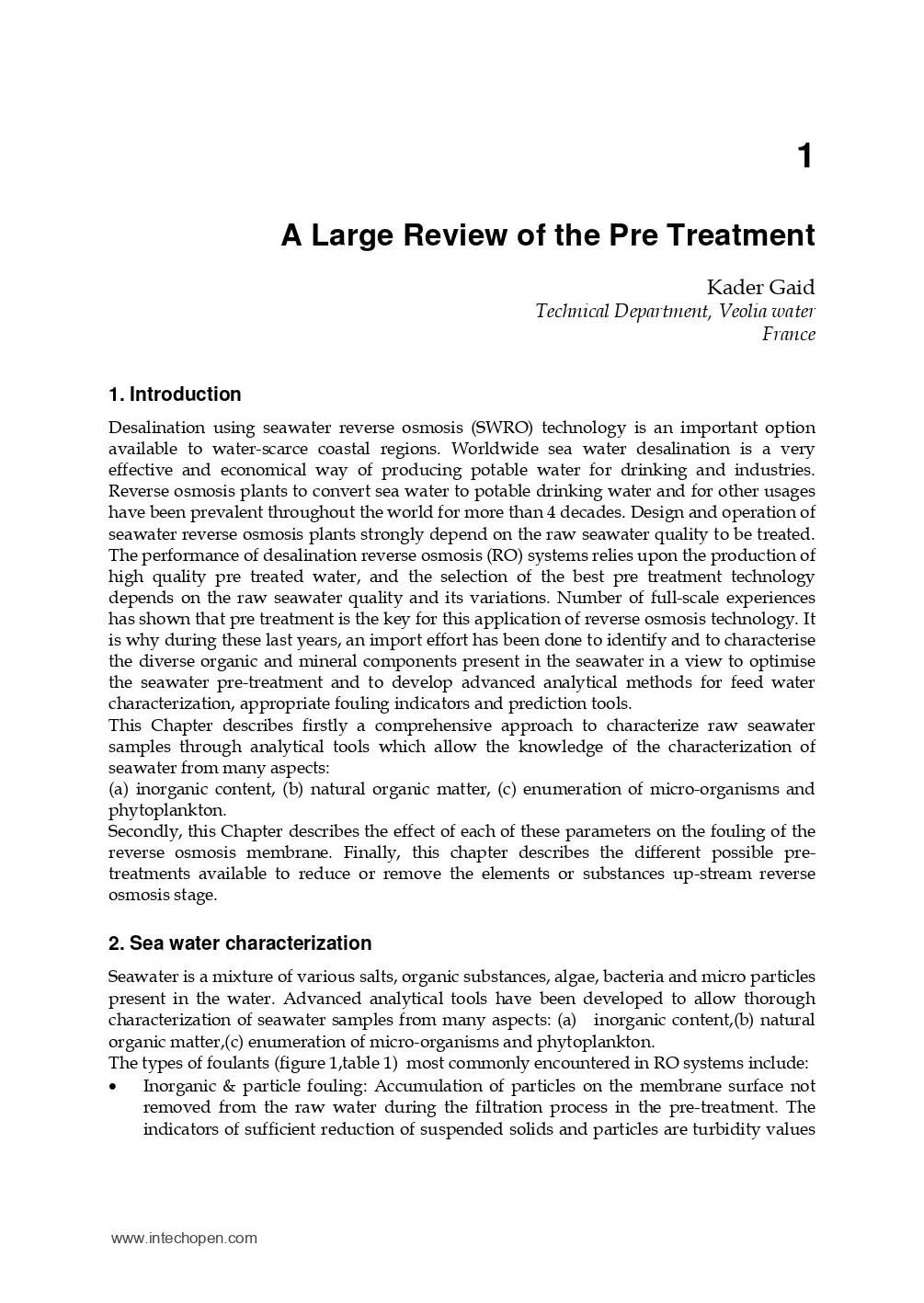Organics & Inorganics Removal
Source : https://www.cranfield.ac.uk/
Presented by : Peter Jarvis
Usually dispatched in 2 to 3 days
Usually dispatched in 2 to 3 days
Category:
Drinking Water Treatment
Only logged in customers who have purchased this product may leave a review.
Related products
Aerogel & Iron-Oxide Impregnated Granular Activated Carbon Media For Arsenic Removal
The goal of this project is to validate proof-of-concept testing for iron enriched granular activated carbon (GAC) composites (aerogel-GAC or iron-oxide impregnated) as a viable adsorbent for removing arsenic from groundwater and conduct technical and economic feasibility assessments for these innovative processes. Specific project objectives include: • Conduct batch experiments for aerogel-GAC and Fe-oxide impregnated GAC composites to evaluate their performance removing arsenic.
• Evaluate Fe-GAC media performance in rapid small scale column tests (RSSCTs) to assess arsenic removal in a more dynamic treatment system.
• Evaluate Fe-GAC potential for removal of other contaminants (e.g., methyl tertiary butyl ether, dissolved organic carbon).
• Characterize Fe-GAC media.
• Correlate performance and media characterization for possible selection of two media for a future second phase of this project.
Aerogel & Iron-Oxide Impregnated Granular Activated Carbon Media For Arsenic Removal
The goal of this project is to validate proof-of-concept testing for iron enriched granular activated carbon (GAC) composites (aerogel-GAC or iron-oxide impregnated) as a viable adsorbent for removing arsenic from groundwater and conduct technical and economic feasibility assessments for these innovative processes. Specific project objectives include: • Conduct batch experiments for aerogel-GAC and Fe-oxide impregnated GAC composites to evaluate their performance removing arsenic.
• Evaluate Fe-GAC media performance in rapid small scale column tests (RSSCTs) to assess arsenic removal in a more dynamic treatment system.
• Evaluate Fe-GAC potential for removal of other contaminants (e.g., methyl tertiary butyl ether, dissolved organic carbon).
• Characterize Fe-GAC media.
• Correlate performance and media characterization for possible selection of two media for a future second phase of this project.
Package Plants For Drinking Water Treatment
In efforts to make package plants more compact, affordable and easier to operate and maintain, it has been noted that the design and performance of some of these plants containing conventional treatment processes is sometimes compromised if technical expertise in this regard is lacking. Generally, there are several risks associated with poorly designed treatment systems, including loss of production, poor safety and compromised equipment and process unit efficiency with associated higher operating and maintenance costs. These risks have more severe consequences in the case of desalination (including water reclamation and water re-use) package plants. The objective of this project is to develop a set of guidelines to assist municipalities, water treatment practitioners, designers and package plant manufacturers in the specification and design of appropriate unit processes and operating parameters to fit the influent water quality, operating environment and other special treatment requirements.
Package Plants For Drinking Water Treatment
In efforts to make package plants more compact, affordable and easier to operate and maintain, it has been noted that the design and performance of some of these plants containing conventional treatment processes is sometimes compromised if technical expertise in this regard is lacking. Generally, there are several risks associated with poorly designed treatment systems, including loss of production, poor safety and compromised equipment and process unit efficiency with associated higher operating and maintenance costs. These risks have more severe consequences in the case of desalination (including water reclamation and water re-use) package plants. The objective of this project is to develop a set of guidelines to assist municipalities, water treatment practitioners, designers and package plant manufacturers in the specification and design of appropriate unit processes and operating parameters to fit the influent water quality, operating environment and other special treatment requirements.
Biological Biofilm Processes
•Used for removal of organic pollutants from wastewaters
•Biological treatment is popular due to:
–low cost
–effective in removal of a wide range of organic contaminants
–effective in removal of colloidal organics
–can remove toxic non-organic pollutants such as heavy metals
Biological Biofilm Processes
•Used for removal of organic pollutants from wastewaters
•Biological treatment is popular due to:
–low cost
–effective in removal of a wide range of organic contaminants
–effective in removal of colloidal organics
–can remove toxic non-organic pollutants such as heavy metals
Arsenic Removal From Drinking Water By Advanced Filtration Processes
All over the world the presence of arsenic in water sources for human consumption has been raising great concern in terms of public health since many epidemiologic studies confirm the potential carcinogenic effect of arsenic. Because arsenic removal is the most frequent option for safe drinking water, the development of more efficient and sustainable technologies is extremely important. Membrane separation processes are suitable for water treatment because they can provide an absolute barrier for bacteria and viruses, besides removing turbidity and colour. Their application is a promising technology in arsenic removal since it does not require the addition of chemical reagents nor the preliminary oxidation of arsenite required in conventional treatment options. However, since membrane technologies such as reverse osmosis can be a very expensive and unsustainable treatment option for small water supply
systems, it becomes crucial that alternative methods are developed. This work presents a few conclusions based on a laboratorial study performed to evaluate the efficiency of arsenic removal using ultrafiltration, microfiltration and solar oxidation processes under different experimental conditions for relevant parameters. The results showed removal efficiencies higher than 90%. Key-words: safe drinking water, arsenic removal, membranes, public health.
Arsenic Removal From Drinking Water By Advanced Filtration Processes
All over the world the presence of arsenic in water sources for human consumption has been raising great concern in terms of public health since many epidemiologic studies confirm the potential carcinogenic effect of arsenic. Because arsenic removal is the most frequent option for safe drinking water, the development of more efficient and sustainable technologies is extremely important. Membrane separation processes are suitable for water treatment because they can provide an absolute barrier for bacteria and viruses, besides removing turbidity and colour. Their application is a promising technology in arsenic removal since it does not require the addition of chemical reagents nor the preliminary oxidation of arsenite required in conventional treatment options. However, since membrane technologies such as reverse osmosis can be a very expensive and unsustainable treatment option for small water supply
systems, it becomes crucial that alternative methods are developed. This work presents a few conclusions based on a laboratorial study performed to evaluate the efficiency of arsenic removal using ultrafiltration, microfiltration and solar oxidation processes under different experimental conditions for relevant parameters. The results showed removal efficiencies higher than 90%. Key-words: safe drinking water, arsenic removal, membranes, public health.
An Energy-Efficient and Sustainable, Microbial Electrolysis- Deionization System for Salt and Organics Removal
The University of Tennessee, Knoxville (UTK) received funding from the Bureau of Reclamation (Reclamation) in September 2013 to investigate a novel salt and organic removal technology. Using microbial electrolysis cell (MEC) technology and salt removal via capacitive deionization (CDI) to remove organic compounds present in produced water was investigated. This project was conducted in collaboration with CAP Holdings Company (CHC), which provided expertise in CDI technology. Converting soluble organic compounds via MEC was coupled to salt removal via CDI, providing a proof of principle for synergistic salt and organic removal. Hydrogen was generated by MEC from organic compounds and used to produce renewable electricity via a polymer electrolyte membrane (PEM) fuel cell , which was then used to power the CDI cell to achieve deionization.
An Energy-Efficient and Sustainable, Microbial Electrolysis- Deionization System for Salt and Organics Removal
The University of Tennessee, Knoxville (UTK) received funding from the Bureau of Reclamation (Reclamation) in September 2013 to investigate a novel salt and organic removal technology. Using microbial electrolysis cell (MEC) technology and salt removal via capacitive deionization (CDI) to remove organic compounds present in produced water was investigated. This project was conducted in collaboration with CAP Holdings Company (CHC), which provided expertise in CDI technology. Converting soluble organic compounds via MEC was coupled to salt removal via CDI, providing a proof of principle for synergistic salt and organic removal. Hydrogen was generated by MEC from organic compounds and used to produce renewable electricity via a polymer electrolyte membrane (PEM) fuel cell , which was then used to power the CDI cell to achieve deionization.
Module 11: Administration of Water Treatment Plants
• Describe how water treatment plants comply with their minimum federal and state monitoring requirements.
• List the three ways in which management ensures that the staff complies with monitoring requirements.
• Discuss reporting requirements when complying with federal and state regulations.
Module 11: Administration of Water Treatment Plants
• Describe how water treatment plants comply with their minimum federal and state monitoring requirements.
• List the three ways in which management ensures that the staff complies with monitoring requirements.
• Discuss reporting requirements when complying with federal and state regulations.
Big Data Analysis For Studying Water Supply And Sanitation Coverage In Cities (Russia)
Big data analysis for water supply and sanitation is important for ensuring urban viability. Our research is devoted to studying the methodology for analyzing big data of the water supply and sanitation systems. Based on a review of scientific publications and their analysis, a model for analyzing large data was proposed. It comprises information sources, data collection and storage platforms with indication of parameters for the programming model, runtime and
storage environment, as well as data analysis and processing.
Big Data Analysis For Studying Water Supply And Sanitation Coverage In Cities (Russia)
Big data analysis for water supply and sanitation is important for ensuring urban viability. Our research is devoted to studying the methodology for analyzing big data of the water supply and sanitation systems. Based on a review of scientific publications and their analysis, a model for analyzing large data was proposed. It comprises information sources, data collection and storage platforms with indication of parameters for the programming model, runtime and
storage environment, as well as data analysis and processing.
An Integrated Photoelectrochemical Zero Liquid Discharge System for Inland Brackish Water Desalination
Surging population, energy demands, and climate change will push us, ever more urgently, to find new approaches to meet growing water demands. Most often, this will involve harvesting lower quality or impaired water supplies (e.g., seawater or brackish groundwater) as a source for drinking water. Recently desalination using membrane-based processes (e.g., reverse osmosis [RO], electrodialysis [ED], and nanofiltration [NF]) has shown promise for providing additional sources of fresh water across the United States. However, the current membrane separation processes are commonly energy intensive and produce large volumes of concentrated brine which poses unique challenges. Particularly in land-locked urban center brine disposal often relyes on surface water discharge or deep-well injection which pose economic and practical difficulties for wide-spread adoption of such technologies. Thus, there is an urgent need for energy-efficient desalination technologies that reduce the amount of concentrate produced, or identify cost-effective solutions for concentrate management.
An Integrated Photoelectrochemical Zero Liquid Discharge System for Inland Brackish Water Desalination
Surging population, energy demands, and climate change will push us, ever more urgently, to find new approaches to meet growing water demands. Most often, this will involve harvesting lower quality or impaired water supplies (e.g., seawater or brackish groundwater) as a source for drinking water. Recently desalination using membrane-based processes (e.g., reverse osmosis [RO], electrodialysis [ED], and nanofiltration [NF]) has shown promise for providing additional sources of fresh water across the United States. However, the current membrane separation processes are commonly energy intensive and produce large volumes of concentrated brine which poses unique challenges. Particularly in land-locked urban center brine disposal often relyes on surface water discharge or deep-well injection which pose economic and practical difficulties for wide-spread adoption of such technologies. Thus, there is an urgent need for energy-efficient desalination technologies that reduce the amount of concentrate produced, or identify cost-effective solutions for concentrate management.
A Large Review of the Pre Treatment
Introduction:
Desalination using seawater reverse osmosis (SWRO) technology is an important option available to water-scarce coastal regions. Worldwide sea water desalination is a very effective and economical way of producing potable water for drinking and industries. Reverse osmosis plants to convert sea water to potable drinking water and for other usages have been prevalent throughout the world for more than 4 decades. Design and operation of seawater reverse osmosis plants strongly depend on the raw seawater quality to be treated. The performance of desalination reverse osmosis (RO) systems relies upon the production of high quality pre treated water, and the selection of the best pre treatment technology depends on the raw seawater quality and its variations. Number of full-scale experiences has shown that pre treatment is the key for this application of reverse osmosis technology. It is why during these last years, an import effort has been done to identify and to characterise the diverse organic and mineral components present in the seawater in a view to optimise the seawater pre-treatment and to develop advanced analytical methods for feed water characterization, appropriate fouling indicators and prediction tools. This Chapter describes firstly a comprehensive approach to characterize raw seawater samples through analytical tools which allow the knowledge of the characterization of seawater from many aspects: (a) inorganic content, (b) natural organic matter, (c) enumeration of micro-organisms and phytoplankton. Secondly, this Chapter describes the effect of each of these parameters on the fouling of the reverse osmosis membrane. Finally, this chapter describes the different possible pre treatments available to reduce or remove the elements or substances up-stream reverse osmosis stage.
A Large Review of the Pre Treatment
Introduction:
Desalination using seawater reverse osmosis (SWRO) technology is an important option available to water-scarce coastal regions. Worldwide sea water desalination is a very effective and economical way of producing potable water for drinking and industries. Reverse osmosis plants to convert sea water to potable drinking water and for other usages have been prevalent throughout the world for more than 4 decades. Design and operation of seawater reverse osmosis plants strongly depend on the raw seawater quality to be treated. The performance of desalination reverse osmosis (RO) systems relies upon the production of high quality pre treated water, and the selection of the best pre treatment technology depends on the raw seawater quality and its variations. Number of full-scale experiences has shown that pre treatment is the key for this application of reverse osmosis technology. It is why during these last years, an import effort has been done to identify and to characterise the diverse organic and mineral components present in the seawater in a view to optimise the seawater pre-treatment and to develop advanced analytical methods for feed water characterization, appropriate fouling indicators and prediction tools. This Chapter describes firstly a comprehensive approach to characterize raw seawater samples through analytical tools which allow the knowledge of the characterization of seawater from many aspects: (a) inorganic content, (b) natural organic matter, (c) enumeration of micro-organisms and phytoplankton. Secondly, this Chapter describes the effect of each of these parameters on the fouling of the reverse osmosis membrane. Finally, this chapter describes the different possible pre treatments available to reduce or remove the elements or substances up-stream reverse osmosis stage.















Reviews
There are no reviews yet.